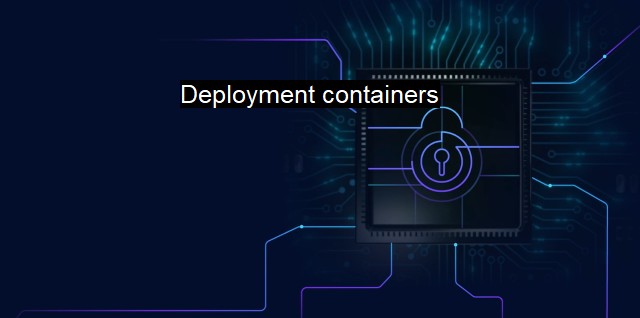What are Deployment containers?
Deploying Containers: Revolutionizing Cybersecurity and Antivirus Systems"
Deployment containers refer to a software technology that delivers an application and its runtime environment in a single, isolated package. Also known as containerization, this approach effectively mimics the principles of shipping containers used in the logistics industry. The purpose is to develop once and deploy anywhere.Deployment containers offer a myriad of benefits along with certain drawbacks. On one side, they contribute to the technological convenience of the updated application distribution process by its rapid and seamless deployment. They also lay the groundwork for continuous integration and delivery of software updates, as they can engage opera system-based or machine-specific libraries and settings without mixing any development environment. the use of such containers results in the seamless integration and automation of the software updates swiftly and incrementally that directly enables an organization to mitigate IT risks and ensure continuity of services.
When it comes to deployment containers, cybersecurity becomes an issue of utmost significance, as the isolated environments of containers elevates the risks of cyber threats. The understanding and proper treatment of deployment containers become more critical regarding the repetitive or unintended deployment of malicious or compromised software.
Antivirus solutions play a crucial role in this context, providing an essential defense to protect the integrity of the isolated containers' environment. They function by continually examining systems for any abnormal behavior or vulnerabilities which could allow rogue applications or malicious software to penetrate the systems. In this regard, antivirus solutions need to include a set of security considerations and measures to validate and protect the containers effectively.
Deployment containers typically consist of various layers having distinctive security levels and checks. Antivirus solutions employed must run layer-wise vulnerability scans to identify and eliminate potential threats before distributing the containers. these solutions should be configured to routinely scan all the layers, including those under development, to arrest any dormant or existing vulnerabilities early in the development process.
The security strategies for containers should also encompass controls for access permissions and privilege. This includes necessary actions, such as enforcing two-factor or multi-factor authentication, tools for logging and auditing container activities, deploying intrusion detection systems with the capability to isolate and take down compromised systems without affecting others, etc. These help to mitigate common cybersecurity risks associated with containers deployment processes.
When given the decentralized characteristic of global communication and digital operations, the security of deployment containers necessitates not only the inclusion of a robust layered defense mechanism for protecting software delivery networks but also involves processes for correct deployment container definitions. This involves educating the development team regarding safer security practices and clarity about container customization rules and their interfaces, along with rightful network path definitions.
Another significant point to consider is that deployment containers typically hold the position of being top amplifiers of cybersecurity threats if they lack proper configuration that comports with an organization's security protocols. Therefore, container orchestration tools that assist in automating the deployment, scaling, and management of applications must also work in conjunction with the cybersecurity policies to assure an all-rounded and fail-proof defense mechanism.
While deployment containers offer numerous benefits such as convenient distribution and seamless application updates, they also pose substantial cybersecurity threats if not approached with proper handling and risk awareness. By implementing antivirus solutions and comprehensive security measures ranging from vulnerability scans to enforcing access permissions and privileges, companies can effectively prepare and manage the container in such a way to assure its resilience against cyber threats. Doing so this not only protects the technological infrastructure but also maintains the integrity of the services provided.

Deployment containers FAQs
What are deployment containers and how do they relate to cybersecurity?
Deployment containers are a type of virtualization technology that allow for the quick and efficient deployment of applications and services. From a cybersecurity perspective, deploying applications in containers can increase security by isolating them from the rest of the system, reducing the attack surface and minimizing the impact of any security breaches.How can deployment containers be used to improve antivirus protection?
Antivirus software can be included as part of a container image and deployed alongside other applications. This allows for consistent and reliable antivirus protection across multiple instances of an application or service. Additionally, containers can be set up to automatically scan for malware and other threats before running an application, providing an additional layer of protection.What are some best practices for securing deployment containers?
Some best practices for securing deployment containers include using only trusted container images and repositories, keeping container images up-to-date with security patches, limiting container privileges, and monitoring container activity for signs of suspicious behavior. It's also important to regularly audit container configurations and perform vulnerability assessments.Can deployment containers help with compliance requirements relating to antivirus protection?
Yes, deployment containers can help with compliance requirements by providing a centralized way to manage antivirus protection across multiple instances of an application or service. By including antivirus software as part of a container image, organizations can ensure consistent and reliable antivirus protection that meets compliance standards. Additionally, containers can be configured to log antivirus activity, making it easier to demonstrate compliance during audits.| | A | | | B | | | C | | | D | | | E | | | F | | | G | | | H | | | I | | | J | | | K | | | L | | | M | |
| | N | | | O | | | P | | | Q | | | R | | | S | | | T | | | U | | | V | | | W | | | X | | | Y | | | Z | |
| | 1 | | | 2 | | | 3 | | | 4 | | | 7 | | | 8 | | |||||||